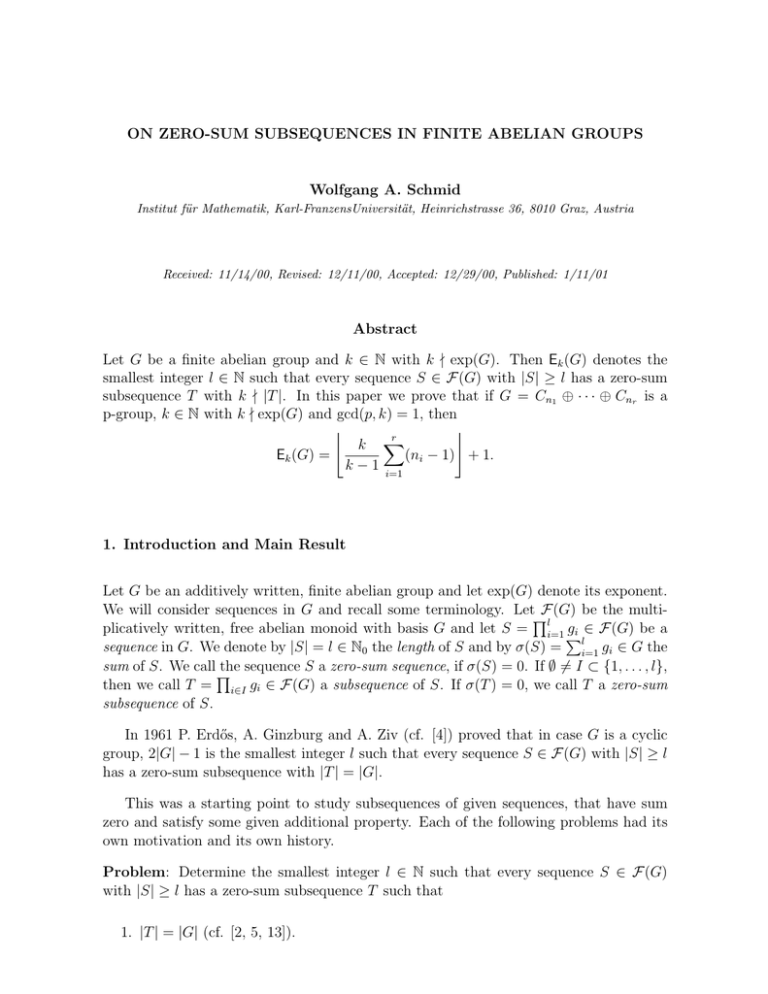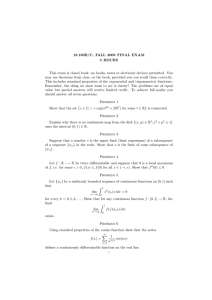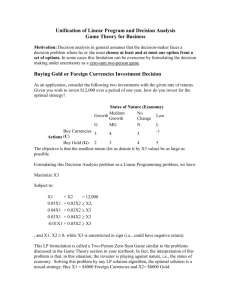ON ZERO-SUM SUBSEQUENCES IN FINITE ABELIAN GROUPS Wolfgang A. Schmid
advertisement

ON ZERO-SUM SUBSEQUENCES IN FINITE ABELIAN GROUPS
Wolfgang A. Schmid
Institut für Mathematik, Karl-FranzensUniversität, Heinrichstrasse 36, 8010 Graz, Austria
Received: 11/14/00, Revised: 12/11/00, Accepted: 12/29/00, Published: 1/11/01
Abstract
Let G be a finite abelian group and k ∈ N with k - exp(G). Then Ek (G) denotes the
smallest integer l ∈ N such that every sequence S ∈ F(G) with |S| ≥ l has a zero-sum
subsequence T with k - |T |. In this paper we prove that if G = Cn1 ⊕ · · · ⊕ Cnr is a
p-group, k ∈ N with k - exp(G) and gcd(p, k) = 1, then
$
%
r
k X
Ek (G) =
(ni − 1) + 1.
k − 1 i=1
1. Introduction and Main Result
Let G be an additively written, finite abelian group and let exp(G) denote its exponent.
We will consider sequences in G and recall some terminology. LetQF(G) be the multigi ∈ F(G) be a
plicatively written, free abelian monoid with basis G and let S = li=1 P
sequence in G. We denote by |S| = l ∈ N0 the length of S and by σ(S) = li=1 gi ∈ G the
sum of S. We call Q
the sequence S a zero-sum sequence, if σ(S) = 0. If ∅ 6= I ⊂ {1, . . . , l},
then we call T = i∈I gi ∈ F(G) a subsequence of S. If σ(T ) = 0, we call T a zero-sum
subsequence of S.
In 1961 P. Erdős, A. Ginzburg and A. Ziv (cf. [4]) proved that in case G is a cyclic
group, 2|G| − 1 is the smallest integer l such that every sequence S ∈ F(G) with |S| ≥ l
has a zero-sum subsequence with |T | = |G|.
This was a starting point to study subsequences of given sequences, that have sum
zero and satisfy some given additional property. Each of the following problems had its
own motivation and its own history.
Problem: Determine the smallest integer l ∈ N such that every sequence S ∈ F(G)
with |S| ≥ l has a zero-sum subsequence T such that
1. |T | = |G| (cf. [2, 5, 13]).
INTEGERS: ELECTRONIC JOURNAL OF COMBINATORIAL NUMBER THEORY 1 (2001), #A01
2
2. |T | = exp(G) (cf. [1, 14, 15]).
3. 1 ≤ |T | ≤ exp(G) (cf. [9]).
4. T is a product of k zero-sum subsequences (for given k ∈ N) (cf. [12]).
Recently W. D. Gao studied Problem 2 in a series of papers (cf. [6, 7, 8]). To do so
he introduced the following invariant.
Definition 1.1. Let G be a finite abelian group and k ∈ N with k - exp(G). Then Ek (G)
denotes the smallest integer l ∈ N such that every sequence S ∈ F(G) with |S| ≥ l has
a zero-sum subsequence T with k - |T |.
W. D. Gao showed how the invariant is related with Problem 2 and he determined
E2 (G) in case G is a p-group with odd p or G is a cyclic group of odd order (cf. [8]).
In this paper we determine Ek (G) in case G is a p-group, k ∈ N with k - exp(G) and
gcd(p, k) = 1.
For some real number x ∈ R let bxc = max{m ∈ Z | m ≤ x} and for some n ∈ N let
Cn denote the cyclic group with n elements.
The aim of the paper is to prove the following result:
Theorem 1.2. Let G = Cn1 ⊕ · · · ⊕ Cnr be a p-group, k ∈ N with k - exp(G) and
gcd(p, k) = 1. Then
$
%
r
k X
Ek (G) =
(ni − 1) + 1.
k − 1 i=1
2. Proof of the Main Result
Throughout, let G denote a finite abelian group and let k ∈ N with k - exp(G). If
|G| > 1, then there are uniquely determined n1 , . . . , nr ∈ N with 1 < n1 | . . . |nr and
G∼
= Cn1 ⊕ · · · ⊕ Cnr .
If |G| = 1, we set r = nr = 1.
Let D(G) denote Davenport’s constant, which is defined as the smallest integer l ∈ N
such that every sequence S ∈ F(G) with |S| ≥ l contains a zero-sum subsequence.
Furthermore, let s(G) denote the invariant arising from Problem 2, i.e. the smallest
integer l ∈ N such that every sequence S ∈ F(G) with |S| ≥ l has a zero-sum subsequence
T such that |T | = exp(G). We start with a simple lemma showing relations between
D(G), s(G) and Ek (G)
INTEGERS: ELECTRONIC JOURNAL OF COMBINATORIAL NUMBER THEORY 1 (2001), #A01
Lemma 2.1.
3
1. D(G) ≤ Ek (G) ≤ s(G).
2. If D(G) < k, then D(G) = Ek (G).
Proof. The inequality D(G) ≤ Ek (G) holds by definition. The inequaltiy Ek (G) ≤ s(G)
holds, since k - exp(G) and therefore a zero-sum subsequence of length exp(G) is as well
a zero-sum subsequence of length not divisible by k.
To prove D(G) = Ek (G), in case D(G) < k, it suffices to prove Ek (G) ≤ D(G). Let
T ∈ F(G) with |T | = D(G). By definition T has a zero-sum subsequence Z. Since
|Z| ≤ |T | < k, we have k - |T |. Therefore every S ∈ F(G) with |S| ≥ D(G), has a
zero-sum subsequence of length not divisible by k. This implies Ek (G) ≤ D(G).
In various problems involving zero-sum sequences it has turned out to be useful to
reformulate the original problem into an equivalent one involving zerofree sequences (as
usual, we call a sequence zerofree, if it has no zero-sum subsequence). This procedure
proved successful in all investigations on the generalized Davenport’s constant (cf. Problem 4 of the Introduction) and in all investigations on the cross number of sequences (cf.
[10, 11]). Although the above reformulation of the given problem is quite simple in many
cases, we regard this as a key idea which we are going to apply for investigating Ek (G).
We need some further notations. Let d(G) denote the largest integer l ∈ N such that
there exists a sequence S ∈ F(G) which is zerofree and has length l. It is well known
that
D(G) = d(G) + 1
and
r
X
(ni − 1) ≤ d(G).
i=1
Definition 2.2. Let ek (G) denote the largest integer l ∈ N such that there exists a
sequence S ∈ F(G) with |S| = l and k | |T | for all zero-sum subsequences T of S.
The following will show that there are relations among Ek (G) and ek (G), which are
similar to those among D(G) and d(G).
Lemma 2.3.
Ek (G) = ek (G) + 1.
Proof. By definition, ek (G) < Ek (G). Indeed, there exists a sequence S ∈ F(G) of length
ek (G) such that k divides the lengths of all zero-sum subsequences of S. On the other
hand, the maximality of ek (G) implies that every sequence with length greater ek (G) has
a zero-sum subsequence with length not divisible by k. Therefore Ek (G) ≤ ek (G) + 1,
and the equality follows.
INTEGERS: ELECTRONIC JOURNAL OF COMBINATORIAL NUMBER THEORY 1 (2001), #A01
Lemma 2.4.
$
4
%
r
k X
(ni − 1) ≤ ek (G).
k − 1 i=1
¥ k Pr
¦
Proof. The proof is done by construction of a sequence of length k−1
(n
−
1)
such
i
i=1
that k divides the length of every zero-sum subsequence. Let e1 , . . . , er ∈ G such that
G = he1 i ⊕ · · · ⊕ her i
and ord(ei ) = ni for all i ∈ {1, . . . , r}.
Q
If S 0 = P ri=1 (−ei )(ni −1) , then S 0 is zerofree and it remains to construct a sequence S 00
r
(n −1)
of length b i=1k−1i c such that k | |Z| for every zero-sum subsequence Z of S 0 S 00 . We
Q
(n −1)
consider the sequence T = ri=1 ei i , which is zerofree and we write it as a product of
sequences B1 , . . . , Bl of length k − 1 and a rest R of length less than k − 1:
l
Y
T = ( Bi )R
i=1
with |Bi | = k − 1 for all i ∈ {1, . . . , l} and 0 ≤ |R| < k − 1. We define
00
S =
l
Y
σ(Bi ).
i=1
Pr
(n −1)
|T |
It follows that S 00 is zerofree and has length |S 00 | = l = b k−1
c = b i=1k−1i c. Therefore
¥
¦
P
r
k
|S 0 S 00 | = k−1
i=1 (ni − 1) , and it remains to show that k divides the length of every
zero-sum subsequence. Let Z denote an arbitrary zero-sum subsequence of S 0 S 00 . Since
S 0 and S 00 are both zerofree, Z can be written as Z 0 Z 00 with subsequences Z 0 of S 0 and
P
Z 00 of S 00 . Every element z 00 of Z 00 can be written in the form z 00 = k−1
j=1 eij with suitable
Qk−1
ij ∈ {1, . . . , r}. Since Z is a zero-sum sequence, we get j=1 (−eij )|Z 0 . The zero-sum
Q
sequence z 00 ( k−1
j=1 (−eij )) is of length k and Z can be written as a product of sequences
of this form. Therefore k divides |Z|.
Lemma 2.5. If G = G1 ⊕ G2 , then
ek (G1 ) + ek (G2 ) ≤ ek (G).
Proof. Since exp(G) = lcm(exp(G1 ), exp(G2 )) and k - exp(G), it follows that k - exp(G1 )
and k - exp(G2 ). Therefore ek (G1 ) and ek (G2 ) are well-defined. For i ∈ {1, 2} let
Si ∈ F(Gi ) be a sequence with |Si | = ek (Gi ) such that for every zero-sum subsequence
Ti of Si , k divides |Ti |. We define S = S1 S2 ∈ F(G). For every zero-sum subsequence T
of S, there exist Ti ∈ F(Gi ) for i ∈ {1, 2} such that T = T1 T2 . Since T has sum zero,
the sequences T1 and T2 have sum zero too. Due to the definition of S1 and S2 , we have
INTEGERS: ELECTRONIC JOURNAL OF COMBINATORIAL NUMBER THEORY 1 (2001), #A01
5
k | |T1 | and k | |T2 |. Therefore k | |T1 | + |T2 | = |T | and S is a sequence in G of length
ek (G1 ) + ek (G2 ), for which every zero-sum subsequence has a length divisible by k. By
definition of ek (G), we have
ek (G1 ) + ek (G2 ) = |S1 | + |S2 | = |S| ≤ ek (G).
For the proof of Theorem 1.2 we need two results on p-groups. The first result has
been proved independently by D. Kruyswijk and J. E. Olson (cf. [3, 16])
P
Theorem 2.6. If G is a p-group, then d(G) = ri=1 (ni − 1).
Theorem 2.6 implies that for two p-groups G and H
d(G) + d(H) = d(G ⊕ H).
The second result is due to W. D. Gao. For convenience we repeat its short proof.
Lemma 2.7. [8] Let G be a p-group. Then there exists a p-group H such that D(G ⊕ H)
is a power of p.
Proof. Let G =
of
Lr
i=1
Cpmi with mi ∈ N and M =
Ḡ = CppM −r+1 ⊕
M
Qr
r
M
i=1
mi . Then G is a direct summand
pM −1
m
Cppmii −1
i=1
and by Theorem 2.6
D(Ḡ) =1 + d(Ḡ) = 1 + (pM + 1 − r)(pM − 1) +
1 + (pM + 1)(pM − 1) = p2M .
r
X
pM − 1 mi
(p − 1) =
mi − 1
p
i=1
Now we are ready to prove Theorem 1.2.
Proof of Theorem 1.2. By Lemma 2.3 and Lemma 2.4 it suffices to prove
$
%
r
k X
ek (G) ≤
(ni − 1) .
k − 1 i=1
The proof is done in three steps. In the first and the second step the proof is given for
special groups. In the third step the general case is proved, by using the result for the
groups of special type.
INTEGERS: ELECTRONIC JOURNAL OF COMBINATORIAL NUMBER THEORY 1 (2001), #A01
6
1. Suppose that there exists ¥some n ∈ N such that
d(G) = (k − 1)(pn − 1).
¦
P
r
k
Let S ∈ F(G) with |S| = k−1
i=1 (ni − 1) + 1. We shall prove that S possesses
a zero-sum subsequence T such that k - |T |. This implies that
$
%
r
k X
(ni − 1) .
ek (G) = Ek (G) − 1 ≤ |S| − 1 ≤
k − 1 i=1
We consider the map
(
ζ:
G → G ⊕ Cpn
g 7→ g + e
where G ⊕ Cpn = G ⊕ hei. For W =
F(G ⊕ Cpn ). By Theorem 2.6 we get
|S| =
Ql
i=1
gi ∈ F(G) we set ζ(W ) =
Ql
i=1
ζ(gi ) ∈
k
d(G) + 1 = d(G) + 1 + (pn − 1) = k(pn − 1) + 1 < kpn
k−1
and
d(G ⊕ Cpn ) = d(G) + (pn − 1) = k(pn − 1) < |S| = |ζ(S)|.
Therefore, again by Theorem 2.6, there exists a subsequence T of S such that
σ(ζ(T )) = 0. By construction σ(T ) = 0, pn | |T | and, since |T | ≤ |S| < kpn , we
have k - |T |.
2. Suppose that (k − 1) divides d(G).
By Lemma 2.7 there exists a p-group H and an integer n ∈ N such that d(G⊕H) =
pn − 1. If H 0 = Gk−2 ⊕ H k−1 , then d(G ⊕ H 0 ) = d((G ⊕ H)k−1 ) = (k − 1)d(G ⊕ H) =
(k − 1)(pn − 1). Since d(H 0 ) = d((G ⊕ H)k−1 ) − d(G), we also get (k − 1)|d(H 0 ).
From the previous step we obtain
k
k
k
k
d((G ⊕ H)k−1 ) =
d(G ⊕ H 0 ) =
d(G) +
d(H 0 ) ≤
k−1
k−1
k−1
k−1
k
d((G ⊕ H)k−1 ),
ek (G) + ek (H 0 ) ≤ ek (G ⊕ H 0 ) = ek ((G ⊕ H)k−1 ) =
k−1
where the first inequality holds by Lemma 2.4, Theorem 2.6 and the fact that
(k − 1)|d(G) and (k − 1)|d(H 0 ). In this chain of inequalities equality holds and
therefore
$
%
r
X
k
k
ek (G) =
d(G) =
(ni − 1) .
k−1
k − 1 i=1
¥ k Pr
¦
3. Assume to the contrary that k−1
i=1 (ni − 1) + 1 ≤ ek (G).
Since k − 1 divides (k − 1)d(G) = d(Gk−1 ), we obtain by the previous step and
INTEGERS: ELECTRONIC JOURNAL OF COMBINATORIAL NUMBER THEORY 1 (2001), #A01
7
Lemma 2.5:
k d(G) =
¹
º
k
k
(k − 1)(
d(G) − 1) + (k − 1) < (k − 1)
d(G) + (k − 1) =
k−1
k−1
$
%
¹
º
r
k
k X
(k − 1)(
d(G) + 1) = (k − 1)(
(ni − 1) + 1) ≤
k−1
k − 1 i=1
(k − 1)ek (G) ≤ ek (Gk−1 ) = k d(G),
a contradiction. Therefore we have ek (G) ≤
¥
k
k−1
Pr
i=1 (ni
¦
− 1) .
References
[1] N. Alon and M. Dubiner, Zero-sum sets of prescribed size, in: Combinatorics,
Paul Erdős is Eighty, Vol. 1, J. Bolyai Math. Soc., 1993, 33-50.
[2] Y. Caro, Remarks on a Zero-Sum Theorem, J. Combin. Th. Ser. A, 76 (1996),
315-322.
[3] P. van Emde Boas, A combinatorial problem on finite abelian groups II, Report
ZW-1969-007, Math. Centre, Amsterdam.
[4] P. Erdős, A. Ginzburg and A. Ziv, A theorem in additive number theory, Bull.
Research Council Israel 10F (1961), 41-43.
[5] W. D. Gao, A Combinatorial Problem on Finite Abelian Groups, J. Number Th.
58 (1996), 100-103.
[6] W. D. Gao, On zero-sum subsequences of restricted size, J. Number Th. 61 (1996),
97-102.
[7] W. D. Gao, On zero-sum subsequences of restricted size II.
[8] W. D. Gao, On zero-sum subsequences of restricted size III, Ars Combinatoria.
[9] W. D. Gao and A. Geroldinger, On Long Minimal Zero Sequences in Finite
Abelian Groups, Periodica Mathematica Hungarica 38 (3) (1999), 179-211.
[10] A. Geroldinger, The Cross Number of Finite Abelian Groups, J. Number Th.
48 (1994), 219-223.
[11] A. Geroldinger and R. Schneider, The cross number of finite abelian groups
III, Discrete Mathematics 150 (1996), 123-130.
INTEGERS: ELECTRONIC JOURNAL OF COMBINATORIAL NUMBER THEORY 1 (2001), #A01
8
[12] F. Halter-Koch, A Generalisation of Davenport’s Constant and its Arithmetical
Applications, Colloquium Mathematicum 63 (1992), 203-210.
[13] Y. O. Hamidoune, O. Ordaz and A. Ortunio, On a Combinatorial Theorem
of Erdős, Ginzburg and Ziv, Combinatorics, Probability and Computing 7 (1998),
403-412.
[14] H. Harborth, Ein Extremalproblem für Gitterpunkte, J. Reine Angew. Math.
262/263 (1973), 356-360.
[15] A. Kemnitz, On a lattice point problem, Ars Combinatoria 16-B (1983), 151-160.
[16] J. E. Olson, A combinatorial problem on finite abelian groups, I, J. Number Th.
1 (1969), 8-10.






